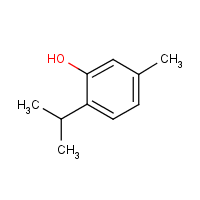Thymol
Agent Name
Thymol
CAS Number
89-83-8
Formula
C10-H14-O
Major Category
Biological Agents

Synonyms
1-Hydroxy-5-methyl-2-isopropylbenzene; 1-Methyl-3-hydroxy-4-isopropylbenzene; 2-Hydroxy-1-isopropyl-4-methylbenzene; 2-Isopropyl-5-methylphenol; 3-Hydroxy-1-methyl-4-isopropylbenzene; 3-Hydroxy-p-cymene; 3-Methyl-6-isopropylphenol; 3-p-Cymenol; 5-Methyl-2-(1-methylethyl)phenol; 5-Methyl-2-isopropyl-1-phenol; 5-Methyl-2-isopropylphenol; 6-Isopropyl-3-methylphenol; 6-Isopropyl-m-cresol; Cymophenol, alpha-; Isopropyl cresol; Phenol, 2-isopropyl-5-methyl-; Phenol, 5-methyl-2-(1-methylethyl)-; Thyme camphor; Thymic acid; Thymol (natural); m-Cresol, 6-isopropyl-; m-Thymol; p-Cymen-3-ol; p-Cymene, 3-hydroxy-; [ChemIDplus]
Category
Plant Oils and Extracts
Description
Colorless or white solid with an herbal odor like thyme; [HSDB] White crystalline solid with an odor like phenol; [MSDSonline]
Sources/Uses
Found in essential oils of Thymus vulgaris and Monardo punctata and other volatile oils; [Merck Index] A natural oil of the plant thyme; [Reference #1] Used as a biocide (mold and mildew), preservative (documents, art objects, and urine), stabilizer (trichloroethylene, chloroform, and halothane), flavoring agent, starting material for racemic menthol, antioxidant, lab reagent, disinfectant in oral hygiene products, antiseptic and antifungal in therapeutic lotions and ointments, and veterinary anthelmintic and antiseptic; [HSDB]
Comments
Mild irritant with systemic effects similar to those of phenol; If ingested causes stomach pain, vomiting, and hyperactivity; Can cause convulsions and coma; Emergency treatment: "Phenol and related agents"; [HSDB] Causes somnolence, ataxia, and coma at lethal doses in rats; [RTECS] Can cause burns; [eChemPortal: ESIS] No increased birth defects in 52 pregnancies with exposure during the first trimester; [REPROTOX] Safe when used as a flavoring agent in food; [JECFA] Causes burns; Harmful if swallowed; [Aldrich MSDS] See "Phenol."
Reference Link #1
Biomedical References
Exposure Assessment
Vapor Pressure
0.0022 mm Hg
Odor Threshold Low
0.001 ppm
Odor Threshold High
0.01 ppm
Explanatory Notes
Odor threshold (detection) = 0.001-0.01 ppm; [CHEMINFO]
Adverse Effects
Neurotoxin
Other CNS neurotoxin
Dermatotoxin
Skin burns
Diseases, Processes, and Activities Linked to This Agent
Processes
Industrial Processes with risk of exposure: